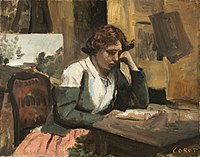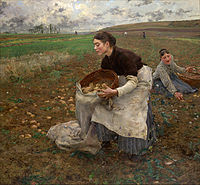Realism (arts)
Realism in
In 19th-century Europe, "Naturalism" or the "Naturalist school" was somewhat artificially erected as a term representing a breakaway sub-movement of realism, that attempted (not wholly successfully) to distinguish itself from its parent by its avoidance of politics and social issues, and liked to proclaim a quasi-scientific basis, playing on the sense of "naturalist" as a student of
There have been various movements invoking realism in the other arts, such as the
.Visual arts
When used as an
Resisting idealization
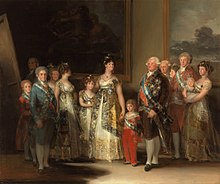
Realism or naturalism as a style meaning the honest, unidealized depiction of the subject, can be used in depicting any type of subject, without any commitment to treating the typical or every day. Despite the general idealism of classical art, this too had classical precedents, which came in useful when defending such treatments in the Renaissance and

A recurring trend in
Renaissance theorists opened a debate, which was to last several centuries, as to the correct balance between drawing art from the observation of nature and from idealized forms, typically those found in classical models, or the work of other artists generally. All admitted the importance of the natural, but many believed it should be idealized to various degrees to include only the beautiful. Leonardo da Vinci was one who championed the pure study of nature, and wished to depict the whole range of individual varieties of forms in the human figure and other things.[5] Leon Battista Alberti was an early idealizer, stressing the typical,[6] with others such as Michelangelo supporting selection of the most beautiful – he refused to make portraits for that reason.[7]
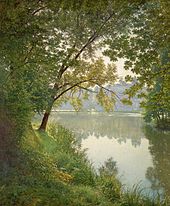
In the 17th century, the debate continued. In Italy, it usually centered on the contrast between the relative "classical-idealism" of
During the 19th century, naturalism developed as a broadly defined movement in European art, though it lacked the political underpinnings that motivated realist artists. The originator of the term was the French art critic Jules-Antoine Castagnary, who in 1863 announced that: "The naturalist school declares that art is the expression of life under all phases and on all levels, and that its sole aim is to reproduce nature by carrying it to its maximum power and intensity: it is truth balanced with science".[9] Émile Zola adopted the term with a similar scientific emphasis for his aims in the novel. Much Naturalist painting covered a similar range of subject matter as that of Impressionism, but using tighter, more traditional brushwork styles, and in landscapes often with more gloomy weather.[9]
The term "continued to be used indiscriminately for various kinds of realism" for several decades, often as a catch-all term for art that was outside Impressionism and later movements of
-
Jean-François Raffaëlli, Outskirts of Paris, 1880s
Illusionism
The development of increasingly accurate representation of the visual appearances of things has a long history in art. It includes elements such as the accurate depiction of the anatomy of humans and animals, of
As well as accuracy in shape, light, and color, Roman paintings show an unscientific but effective knowledge of representing distant objects smaller than closer ones and representing regular geometric forms such as the roof and walls of a room with perspective. This progress in illusionistic effects in no way meant a rejection of idealism; statues of Greek gods and heroes attempt to represent with accuracy idealized and beautiful forms, though other works, such as heads of the famously ugly Socrates, were allowed to fall below these ideal standards of beauty. Roman portraiture, when not under too much Greek influence, shows a greater commitment to a truthful depiction of its subjects, called verism.
The art of
The accurate depiction of landscape in painting had also been developing in Early Netherlandish/Early Northern Renaissance and Italian Renaissance painting, and was then brought to a very high level in 17th-century Dutch Golden Age painting, with very subtle techniques for depicting a range of weather conditions and degrees of natural light. After being another development of Early Netherlandish painting, by 1600 European portraiture could give a very good likeness in both painting and sculpture, though the subjects were often idealized by smoothing features or giving them an artificial pose. Still life paintings, and still life elements in other works, played a considerable role in developing illusionistic painting, though in the Netherlandish tradition of flower painting they long lacked "realism", in that flowers from all seasons were typically used, either from the habit of assembling compositions from individual drawings, or as a deliberate convention; the large displays of bouquets in vases, though close to modern displays of cut flowers that they have influenced, were entirely atypical of 17th-century habits, where flowers were displayed one at a time. Intriguingly, having led the development of illusionic painting, still life was to be equally significant in its abandonment in Cubism.
Depiction of ordinary subjects
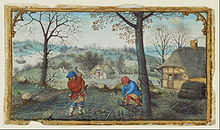
The depiction of ordinary, everyday subjects in art also has a long history, though it was often squeezed into the edges of compositions, or shown at a smaller scale. This was partly because art was expensive, and usually commissioned for specific religious, political or personal reasons, which allowed only a relatively small amount of space or effort to be devoted to such scenes.
Early Netherlandish painting brought the painting of portraits as low down the social scale as the prosperous merchants of
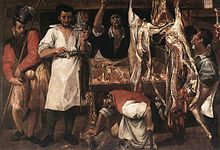
In the 16th century, there was a fashion for the depiction in large paintings of scenes of people working, especially in food markets and kitchens: in many the food is given as much prominence as the workers. Artists included
Much art depicting ordinary people, especially in the form of prints, was comic and moralistic, but the mere poverty of the subjects seems relatively rarely to have been part of the moral message. From the mid-19th century onwards this changed, and the difficulties of life for the poor were emphasized. Despite this trend coinciding with large-scale migration from the countryside to cities in most of Europe, painters still tended to paint poor rural people, largely leaving illustrators such as Gustave Doré to show the horrors of city slums. Crowded city street scenes were popular with the Impressionists and related painters, especially ones showing Paris.
Medieval manuscript illuminators were often asked to illustrate technology, but after the Renaissance such images continued in book illustration and prints, but with the exception of
-
Diego Velázquez, The Farmers' Lunch, c. 1620
-
Adriaen Brouwer, Interior of a Tavern, c. 1630
-
Quiringh van Brekelenkam, Interior of a Tailor's Shop, 1653
-
Giacomo Ceruti, Women Working on Pillow Lace, 1720s
-
-
William Bell Scott Iron and Coal, 1855–1860
-
Jean-Baptiste-Camille Corot, Young Girl Reading, 1868
-
Juan Manuel Blanes, Yellow Fever Episode. 1871
-
Vladimir Makovsky, "Philanthropists", 1874
-
Sir Luke Fildes, The Widower, 1876
-
Luxembourg Gardens. 1887
Realist movement
The Realist movement began in the mid-19th century as a reaction to Romanticism and History painting. In favor of depictions of 'real' life, the Realist painters used common laborers, and ordinary people in ordinary surroundings engaged in real activities as subjects for their works. Its chief exponents were Gustave Courbet, Jean-François Millet, Honoré Daumier, and Jean-Baptiste-Camille Corot.[11][12][13] According to Ross Finocchio, formerly of the Department of European Paintings at the Metropolitan Museum of Art, Realists used unprettified detail depicting the existence of ordinary contemporary life, coinciding with the contemporaneous naturalist literature of Émile Zola, Honoré de Balzac, and Gustave Flaubert.[14]
-
Jean-François Millet, The Gleaners, 1857
-
Honoré Daumier, The Chess Players, 1863
The French Realist movement had equivalents in all other Western countries, developing somewhat later. In particular the Peredvizhniki or Wanderers group in Russia who formed in the 1860s and organized exhibitions from 1871 included many realists such as Ilya Repin, Vasily Perov, and Ivan Shishkin, and had a great influence on Russian art. In Britain artists such as Hubert von Herkomer and Luke Fildes had great success with realist paintings dealing with social issues.
-
Vasily Perov, The Drowned, 1867
-
Religious Procession in Kursk Province, 1880–1883
-
Aleksander Gierymski Feast of Trumpets, 1884
-
Hubert von Herkomer, Hard Times 1885
Literature
Broadly defined as "the faithful representation of reality",
While the preceding
Theatre
Theatrical realism is said to have first emerged in European drama in the 19th century as an offshoot of the Industrial Revolution and the age of science.[24][25] Some also specifically cited the invention of photography as the basis of the realist theater[26][27] while others view that the association between realism and drama is far older as demonstrated by the principles of dramatic forms such as the presentation of the physical world that closely matches reality.[28]
The achievement of realism in the theatre was to direct attention to the social and psychological problems of ordinary life. In its dramas, people emerge as victims of forces larger than themselves, as individuals confronted with a rapidly accelerating world.[29] These pioneering playwrights were unafraid to present their characters as ordinary, impotent, and unable to arrive at answers to their predicaments. This type of art represents what we see with our human eyes. Anton Chekov, for instance, used camera works to reproduce an uninflected slice of life, exposing the rhetorical and suasive character of realistic theatricality.[30] Scholars such as Thomas Postlewait noted that throughout the nineteenth and twentieth centuries, there were numerous joining of melodramatic and realistic forms and functions, which could be demonstrated in the way melodramatic elements existed in realistic forms and vice versa.[31]
In the United States, realism in drama preceded fictional realism by about two decades as theater historians identified the first impetus toward realism during the late 1870s and early 1880s.[32] Its development is also attributed to William Dean Howells and Henry James who served as the spokesmen for realism as well as articulator of its aesthetic principles.[32]
The realistic approach to theater collapsed into nihilism and the absurd after World War II.[24]
Cinema
Aesthetically realist filmmakers use
Opera
Verismo was a post-Romantic operatic tradition associated with Italian composers such as Pietro Mascagni, Ruggero Leoncavallo, Umberto Giordano, Francesco Cilea and Giacomo Puccini. They sought to bring the naturalism of influential late 19th-century writers such as Émile Zola, Gustave Flaubert, and Henrik Ibsen into opera. This new style presented true-to-life drama that featured gritty and flawed lower-class protagonists[35] while some described it as a heightened portrayal of a realistic event.[36] Although an account considered Giuseppe Verdi's Luisa Miller and La Traviata as the first stirrings of the verismo,[37] some claimed that it began in 1890 with the first performance of Mascagni's Cavalleria rusticana, peaked in the early 1900s.[38] It was followed by Leoncavallo's Pagliacci, which dealt with the themes of infidelity, revenge, and violence.[35]
Verismo also reached Britain where pioneers included the
See also
- Aesthetic Realism
- American realism
- Ashcan School
- Aspectism
- Capitalist realism
- Contemporary realism
- Chanson réaliste (realist song), a style of music performed in France primarily from the 1880s until the end of World War II
- Humanist Photography
- Hyperrealism (visual arts)
- Magic realism
- Nouveau réalisme
- Peredvizhniki
- Photorealism
- Pre-Raphaelite Brotherhood
- Pseudorealism
- Romantic realism
- Social realism
- Street Photography
- Verism
Notes
- ^ Sarah Dillon and Amy Raffel (October 2014). "Italian Renaissance Art (1400–1600)". Art History Teaching Resources. AHTR. Retrieved 6 November 2021.
- ^ "Metropolitan Museum of Art". Metmuseum.org. 2014-06-02. Retrieved 2014-07-15.
- ^ Finocchio, Ross. "Nineteenth-Century French Realism". In Heilbrunn Timeline of Art History. New York: The Metropolitan Museum of Art, 2000–. online (October 2004)
- ^ Blunt, 30–32, and the whole short chapter on Leonardo
- ^ Blunt, 14–20
- ^ Blunt, 59–64
- ^ "Quelle che si gloriamo del nome de naturalisti", quoted in Raben, 134, note 31
- ^ a b c Needham
- ^ Chardin served as a forerunner to the Realist movement in French painting. "Without realizing he was doing it, he rejected his own time and opened the door to modernity". Rosenberg, cited by Wilkin, Karen, The Splendid Chardin, New Criterion. Requires subscription. Retrieved 15 October 2008.
- ^ "NGA Realism movement". Nga.gov. 1941-01-06. Archived from the original on 2014-07-14. Retrieved 2014-07-15.
- ^ "National Gallery glossary, Realism movement". Nationalgallery.org.uk. Retrieved 2014-07-15.
- ^ "Philosophy of Realism". Impressionist1877.tripod.com. Retrieved 2014-07-15.
- ^ "Nineteenth-Century French Realism | Thematic Essay | Heilbrunn Timeline of Art History | The Metropolitan Museum of Art". Metmuseum.org. 2014-06-02. Retrieved 2014-07-15.
- ^ Donna M. Campbell. "Realism in American Literature". Wsu.edu. Retrieved 2014-07-15.
- ^ "Realism definition of Realism in the Free Online Encyclopedia". Encyclopedia2.thefreedictionary.com. Retrieved 2014-07-15.
- ISBN 978-1-7936-0910-6.
- ^ in so far as such subjects are "explicable in terms of natural causation without resort to supernatural or divine intervention" Morris, 2003. p. 5
- ^ Watt, 1957, p. 12
- ^ The Literature of Replenishment, later republished in The Friday Book(1984).
- ^ "Victorian Literature". The Literature Network. Retrieved 7 October 2013.
- ^ Gerald Graff (1975) Babbitt at the Abyss: The Social Context of Postmodern. American Fiction, TriQuarterly, No. 33 (Spring 1975), pp. 307–37; reprinted in Putz and Freese, eds., Postmodernism and American Literature.
- ^ Gerald Graff (1973) The Myth of the Postmodernist Breakthrough, TriQuarterly, 26 (Winter, 1973) 383–417; rept in The Novel Today: Contemporary Writers on Modern Fiction Malcolm Bradbury, ed., (London: Fontana, 1977); reprinted in Proza Nowa Amerykanska, ed., Szice Krytyczne (Warsaw, 1984); reprinted in Postmodernism in American Literature: A Critical Anthology, Manfred Putz and Peter Freese, eds., (Darmstadt: Thesen Verlag, 1984), 58–81.
- ^ ISBN 978-0-8386-3421-9.
- ISBN 978-0-13-547861-5.
- ISBN 978-1-111-34831-1.
- ISBN 978-0-415-46223-5.
- ISBN 978-0-7486-3821-5.
- ^ Simard, Rodney. Postmodern Drama: Contemporary Playwrights in America and Britain. New York: UP of America, 1984.
- ISBN 978-0-520-28687-0.
- ISBN 978-0-7486-4520-6.
- ^ ISBN 978-0-521-32711-4.
- ^ a b c d e f Hayward, Susan. "Realism" in Cinema Studies: The Key Concepts (Third Edition). Routledge, 2006. pp. 334–35
- ^ Dudley Andrew, The Major Film Theories: An Introduction, Oxford, New York: Oxford University Press, 1976, Part II.
- ^ ISBN 978-1-78323-121-8.
- ^ ISBN 978-1-84383-542-4.
- ISBN 978-0-521-22824-4.
- ISBN 1-56159-174-2
References
- ISBN 0-19-881050-4
- Morris, Pam (2003). Realism. London: Routledge. ISBN 978-0-415-22938-8.
- Needham, Gerald, "Naturalism." Grove Art Online. Oxford Art Online. Oxford University Press, accessed February 23, 2013, subscriber link
- Raben, Hans, "Bellori's Art: The Taste and Distaste of a Seventeenth-Century Art Critic in Rome", Simiolus: Netherlands Quarterly for the History of Art, Vol. 32, No. 2/3 (2006), pp. 126–46, Stichting voor Nederlandse Kunsthistorische Publicaties, JSTOR
- Watt, Ian (1957). The Rise of the Novel: Studies in Defoe, Richardson and Fielding. Berkeley: University of California Press.
- West, Shearer (1996). The Bullfinch Guide to Art. UK: Bloomsbury Publishing Plc. ISBN 978-0-8212-2137-2.
Further reading
- Buchanan, William (1982), The Realist Tradition, in ISSN 0264-0856
- Dahlhaus, Carl (1985). Realism in Nineteenth-Century Music. Translated by Mary Whittall. Cambridge, London, New York, New Rochelle, Melbourne, Sydney: Cambridge University Press. ISBN 978-0-521-27841-6(pbk).
- Dahlhaus, Carl (1989). Nineteenth-Century Music. Translated by J. Bradford Robinson. Berkeley, Los Angeles, and London: University of California Press. ISBN 978-0-520-07644-0.
- Frisch, Walter (2005). German Modernism: Music and the Arts. Berkeley, Los Angeles, and London: University of California Press. ISBN 978-0-520-25148-9.
External links
- Article on American literary realism at the Literary Movements site
- Art term: Realism at tate.org.uk







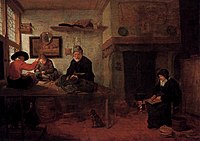

![Jean-Baptiste-Siméon Chardin, Woman Cleaning Turnips, c. 1738, Alte Pinakothek.[10]](http://upload.wikimedia.org/wikipedia/commons/thumb/b/b6/Jean-Baptiste_Sim%C3%A9on_Chardin_017.jpg/161px-Jean-Baptiste_Sim%C3%A9on_Chardin_017.jpg)


